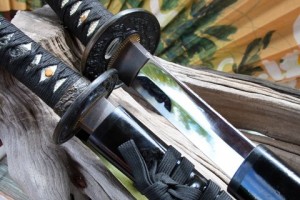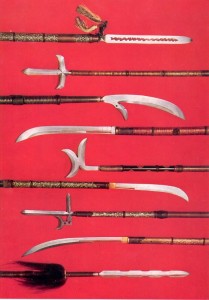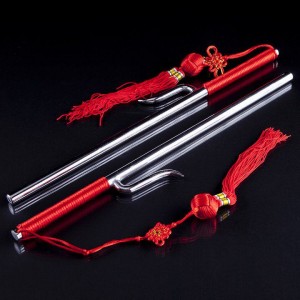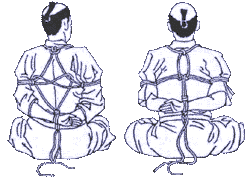BATTOU-JUTSU SOCIETY  – School of Combat Japanese Sword-
– School of Combat Japanese Sword-
AN OVERVIEW OF IAI-JUTSU AND BIKEN-JUTSU and Battou-Jutsu
In the art of Iai-jutsu or its more modern part Iai-do, it is the act of sheathing and unsheathing the sword that makes up the entire art. All actions after the drawing of the sword are called Kenjutsu (method of the sword). It is essential that the sword is drawn with the utmost realistic speed, making use of either its slashing or thrusting capabilities as the terminal phase of the draw. Kenjutsu was designed to be used mostly on even natural terrain while Iai-do can be best appreciated and executed on an ideal floor such as a dojo. These make use of standing (Tachi) and many sitting/squatting (Suwari) techniques.
Biken-jutsu is the methodology and implementation of the real sword. It presents a complete study of the sword. The prevailing components of Biken-jutsu are: Iai-jutsu (sheathing/unsheathing), Ken-jutsu (sword fencing), Tamageshi (test cutting), Muto dori (defense against the sword) and other aspects of the sword as forging, cleansing, and study of its parts.
Biken-jutsu considers all even, uneven and unsteady surfaces as well as various methods of achieving the same goals; the techniques also consider all other elements about as compliment to the sword.
Battou- Jutsu is simply all of the Iaijutsu principles, all of the Biken-jutsu principles with added principles and strategies captured int the real field of experience for combat-oriented applications,
The intention here is not to proclaim a difference as to which is better. There is no such thing for one is of the other; without Iai-jutsu you cannot do Biken-jutsu. One element that stands out the most here is that the dojo or place of training should not be a mural to display your possessions and other distractions; rather, it should be of a religious atmosphere that inspires a sober and reverential frame of mind to you and everyone else who enters it.
BATTOU-JUTSU – UNDER BELT LEVEL (KYU)
Members shall observe the following ranks before achieving Black Belt level. Each kyu is represented by a belt color; thus denoting the student’s advancement. Each level is at least 4 -5 months duration.
Kyukyu…………..……..9th Kyu – White Belt
Hachikyu…….…8th Kyu – White/black stripe
Nanakyu….……7th Kyu – Yellow/black stripe
Rohkkyu………6th Kyu – Orange/black stripe
Gohkyu…….…..5th Kyu – Green/black stripe
Shikyu…….…..….4th Kyu – Blue/black stripe
Sankyu………….3rd Kyu – Purple/black stripe
Nikyu……………..2nd Kyu – Red/black stripe
Ichikyu………….1st Kyu – Brown/black stripe
BATTOU-JUTSU EQUIPMENT REQUIREMENTS
- Gi – Martial arts uniform
- Hakama – Samurai pleated pants
- Bokken – Wooden sword
- Obi – belt (6–9 cm wide, 2–3 times around waist)
- Hachimaki – Head band
- Tabi – Samurai indoor training shoes
- Bikken/Tachi – Real practice sword
- Dojo T-shirt
- Xtreme sword (if desired)
**************************************************************************************
YARI AND NAGINATA JUTSU (METHOD OF THE SPEAR AND HARBERD)
***********************************************************************************
JUTTE JUTSU
Juttejutsu (十手術) is quintissentially the Japanese martial art of using the one prong weapon, jutte (also known as jitte). Juttejutsu was evolved mainly for the law enforcement officers of the Edo period to enable non-lethal disarmament and apprehension of criminals who were usually carrying a sword. Besides the use of striking an assailant on the head, wrists, hands and arms like that of a baton, the jutte can also be used for blocking, deflecting and grappling a sword in the hands of a skilled user.
There are several schools of juttejutsu today and various jutte influences and techniques are featured in several martial arts.
Jutte Jutsu
- Kiri no Hito Ha
- Rakka
- Gorin Kudaki
- Mizu Dori
- Mawari Dori
*****************************************************************
HOJU JUTSU – ART OF RESTRAINING (includes handcuffs techniques)
A Definition
Hojojutsu (hojo-jutsu), also known as Torinawa-jutsu (a different pronunciation of the same root kanji) is quintessentially a japanese martial art, that came into popularity in the 1400s. It incorporates rope as both a weapon and a means of restraining an enemy. Over time, the use of rope on the battlefield moved into law enforcement and remains part of the training for Japanese police today.
As a martial art
The defense methodology involving Hojojutsu focuses on short moves and fast take-downs as those impart in both the Kukishin ryu Ninpo and the Takagi Yohin Ryu Samurai Jutaijutsu, and for this reason, the techniques themselves are very attractive to law enforcement agent and bounty hunters. In this context, the techniques known as Newaza (ground techniques) have been borrowed from Takagi Yoshin Ryu, however, when used within hojojutsu, the terminology Yukawaza is more acurate in discribing floor techniques utilising rope.
very attractive to law enforcement agent and bounty hunters. In this context, the techniques known as Newaza (ground techniques) have been borrowed from Takagi Yoshin Ryu, however, when used within hojojutsu, the terminology Yukawaza is more acurate in discribing floor techniques utilising rope.
*****************************************************************************


